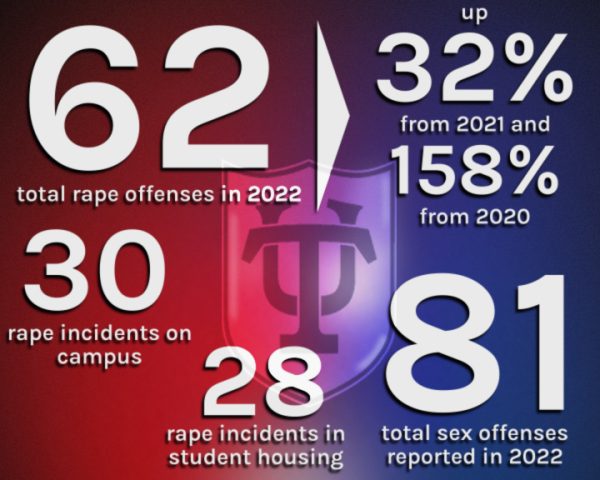Content Warning: This article discusses themes and reports of sexual violence.

Every fall, the Tulane University Police Department distributes its annual security report — mandated by the Clery Act — in an email with an ambiguous subject line: “Notice of Availability – Annual Security and Fire Safety Report.”
Chances are, students take one look at the subject and immediately delete the email.
But if you do decide to scroll through 69 pages of the report, you’ll find campus sexual assault data from the last three years, illustrating a steady increase in reported cases of rape at Tulane since 2020.
In 2022, there were 62 total reported cases of rape. Nearly half of the incidents occurred on campus, while the remaining 32 reports came from off-campus housing or a non-campus building, according to the ASR.
The year prior, the ASR documented a total of 47 cases of rape — 24 reports came from Uptown campus, 21 from off-campus student housing and two reports from a non-campus building or property. This data nearly doubled the reports of rape in 2020, which recorded a total of 24 cases.
Stalking was also reported more often in 2022 with over 40 reports from both on and off campus. In 2021, there were less than 25 reports and, in 2020, less than 10.
While these numbers may seem low compared to Tulane’s student body of over 12,000 students, two out of every three cases of rape go unreported, leaving a disturbing number of assault victims unaccounted for.
In a more drastic report, nearly one-third of undergraduate women reported being raped while at Tulane, according to the 2022 Sexual Misconduct Climate Survey. This is a 6% increase from 2017’s findings.
Instead of addressing the university’s disturbing reality, Tulane’s administration released the results during peak finals season to divert attention from statistics that underscore a deepening issue of rape culture on campus.
As students were studying, finishing papers and prepping for exams, they did not have time to attend a webinar that ultimately sandwiched sexual assault statistics with rates of prior victimization and a PR question asking if the student would still return to the university despite being assaulted.
For over four years, chief of TUPD Kirk Bouyelas sent the same email informing students of their ability to view crime statistics that include offenses of rape, stalking and domestic violence.
Though the reports of assault and harassment have increased from 2020, they are not nearly representative of the actual scale of the rape culture epidemic that inundates campus.
After releasing the 2022 Sexual Misconduct Climate Survey’s self-reported results that greatly overshadowed the ASR’s findings, why haven’t Tulane or TUPD questioned their ability to protect students or found new ways to improve reporting systems?
When students are aware of these reports and can compare the numbers with their personal experience, they may also share my opinion that this data should be addressed, instead of masked as a “fire safety report” and buried under pages of definitions.



PL • Jan 10, 2025 at 8:06 pm
Thank you for sharing, I’m a bit scared to send my child to this school.